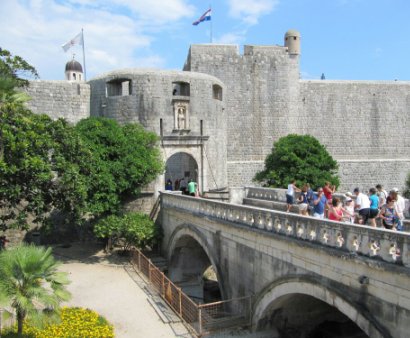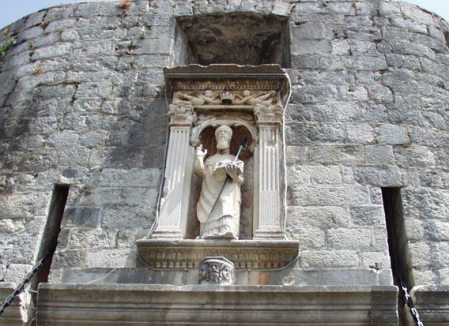


The Pile Gate (Vrata od Pila in Croatian), located on the western edge of Dubrovnik’s UNESCO-listed Old Town, is the grandest and most iconic entrance to the historic fortified city of the former Republic of Ragusa. Constructed primarily in 1537, though incorporating elements from as early as the 13th century, this monumental gateway serves as the primary access point for visitors entering Dubrovnik’s pedestrian-only core from the bustling Pile suburb. Flanked by imposing stone walls and crowned by a statue of St. Blaise, the city’s patron saint, the Pile Gate is both a defensive masterpiece and a ceremonial threshold, blending Gothic, Renaissance, and Baroque architectural styles. Beyond its practical role as a controlled entry, it symbolized the Republic’s autonomy and resilience during its golden age (1358–1808), when Dubrovnik thrived as a maritime power rivaling Venice. Today, it’s a vibrant hub where tourists pour in from cruise ships, locals linger at nearby cafes, and history pulses through every weathered stone, offering a portal to a city that has withstood sieges, earthquakes, and modernity’s pressures.
The Pile Gate’s origins are rooted in Dubrovnik’s evolution as a
fortified city-state. By the 13th century, when the Republic of Ragusa
began consolidating its independence from Venetian and Byzantine
influence, the western approach from the mainland required robust
defenses against potential invaders, including Illyrian tribes,
Ottomans, and rival powers. The earliest iteration of the gate,
documented around 1275, was a simple fortified portal within the city’s
initial walls, built to secure access from the Pile area—a name possibly
derived from the Greek pyle (gate) or Latin pilae (pillars), reflecting
its role as the main landward entry.
The current structure took shape
in 1537, during a period of intense fortification under the Republic’s
Senate, which sought to modernize defenses amid growing Ottoman threats
and regional instability. Designed by local architects and influenced by
Italian Renaissance military engineering, the gate was integrated into
the expanded city walls, which stretched 1,940 meters and included
bastions like Minčeta and Revelin. Its inner and outer arches, connected
by a fortified bridge over a moat, reflect a layered defensive strategy,
allowing guards to monitor and control access while protecting against
artillery advances.
The gate endured the 1667 earthquake, which
devastated Dubrovnik, killing 5,000 and damaging much of the city.
Repairs in the late 17th century added Baroque flourishes, including the
statue of St. Blaise atop the inner arch, sculpted by Ivan Meštrović or
a contemporary. During the 1991–1992 Yugoslav siege, the Pile Gate
witnessed intense shelling, with shrapnel marks still faintly visible on
its outer walls, but its robust construction ensured minimal structural
damage. Post-war restorations (1990s–2000s), supported by UNESCO and
Croatian authorities, preserved its authenticity while reinforcing
weakened stonework.
Historically, the gate was more than a defensive
choke point: it was a ceremonial stage. Merchants, diplomats, and
pilgrims entered here, greeted by the Republic’s banner and St. Blaise’s
protective gaze. The adjacent drawbridge, raised nightly until the 19th
century, underscored Dubrovnik’s insular pride, while the gate’s customs
house processed trade goods fueling the city’s wealth. Today, it remains
a symbolic threshold, welcoming over 3 million annual visitors to a city
of 43,000, its cobblestones worn smooth by centuries of footsteps.
The Pile Gate is a stunning example of layered fortification
architecture, blending functionality with aesthetic grandeur across
its inner and outer components. Spanning roughly 20 meters in depth
and 10 meters in height, it comprises two distinct arches connected
by a stone bridge over a former moat, now a landscaped garden. The
structure is built from Dubrovnik’s signature tura limestone, a
fine-grained, creamy stone that weathers to a warm patina,
harmonizing with the city walls’ rugged elegance.
Outer Gate
(1537): The exterior arch, facing the Pile suburb, is a Renaissance
masterpiece designed by Paskoje Miličević, a local engineer renowned
for his work on the city’s aqueduct. The semi-circular arch, framed
by rusticated stone blocks, exudes classical simplicity, with a
keystone bearing subtle carvings of the Republic’s coat of arms—a
shield with diagonal stripes. Flanking the arch are two cylindrical
turrets, remnants of the 14th-century Asimon Tower, which housed
guards and artillery. The outer gate’s austerity reflects its
defensive purpose: narrow embrasures allowed archers to target
invaders, while a heavy wooden portcullis (now gone) could seal the
passage. Above, a crenelated parapet evokes a fortress-like stance,
softened by climbing ivy added in the 19th century.
Stone Bridge:
Connecting the outer and inner gates is a single-span stone bridge,
reconstructed in 1471 after earlier wooden drawbridges proved
vulnerable. Spanning the 10-meter-wide moat (dry since the 1800s),
the bridge’s gentle arch and balustrades are both functional and
decorative, offering views of the Lovrijenac Fortress to the west.
Its limestone pavers, polished by foot traffic, bear faint
inscriptions from 17th-century repairs.
Inner Gate (13th–17th
century): The inner arch, opening onto the Stradun (Dubrovnik’s main
street), is the gate’s ceremonial heart. Gothic in origin, it was
remodeled in 1537 with Renaissance proportions: a pointed arch gives
way to a smoother, rounded frame, adorned with pilasters and a
frieze of acanthus motifs. Crowning the arch is a niche housing a
Baroque statue of St. Blaise, depicted with a bishop’s mitre and a
model of Dubrovnik, symbolizing his eternal protection. The statue,
likely added post-1667, replaces an earlier effigy damaged in the
quake. The inner gate’s walls, up to 2 meters thick, incorporate
guardrooms and storage for munitions, with narrow staircases (closed
to public) leading to the ramparts.
The gate’s design balances
defense and symbolism: its outer severity deters, while the inner
elegance welcomes. Subtle war scars—1991 shrapnel pocks—and natural
erosion add character, but ongoing maintenance (last major work in
2015) ensures stability. Compared to Venice’s Porta Magna or
Lisbon’s fortified gates, Pile’s compact scale belies its strategic
genius, controlling access while projecting power.
The Pile Gate was the Republic of Ragusa’s front door, embodying its
dual identity as a fortified stronghold and a cosmopolitan hub. As the
primary landward entry, it filtered trade caravans from the Balkan
interior, pilgrims en route to Jerusalem, and diplomats negotiating with
Ottoman pashas. Its drawbridge and St. Blaise statue reinforced the
city’s sovereignty and Catholic devotion, a counterpoint to nearby
Islamic and Orthodox influences. The gate’s customs functions, managed
by the adjacent Guard House, taxed goods like silk and spices, fueling
Dubrovnik’s treasury.
Culturally, it remains a living monument. It
anchors the Dubrovnik Summer Festival (July–August), where actors in
Renaissance costumes stage processions through its arches, evoking the
Republic’s pomp. Locals treat it as a rendezvous point—“meet me at
Pile”—while tourists flock for selfies against its dramatic backdrop.
Its proximity to Onuphrius’ Fountain and the Franciscan Monastery ties
it to Dubrovnik’s civic and spiritual core, a gateway to the Stradun’s
vibrant pulse. For historians, it offers insights into medieval urban
planning and defensive psychology; for residents, it’s a symbol of
endurance, having withstood the 1667 quake, Napoleonic occupation, and
1991 siege.
The gate also reflects environmental adaptation: its
moat, once a defensive barrier, now hosts greenery that cools the
microclimate, a nod to Dubrovnik’s sustainable heritage. Recent debates
about pedestrian congestion highlight its modern challenges, with
proposals for timed entries to manage tourist flows, ensuring
preservation amid 3 million annual visitors.
As of September 17, 2025, the Pile Gate is fully accessible, free to
enter, and open 24/7 as the main pedestrian portal to the Old Town.
Maintained by the Society of Friends of Dubrovnik Antiquities and
UNESCO-funded teams, it underwent minor repairs in 2023 to stabilize the
bridge’s balustrades, with no major damage reported since the 1990s war.
Located at Ulica od Pila, it’s steps from the Pile bus stop (Lines 1A/3
from the airport, €8) or a 15-minute walk from the cruise port. Parking
is limited; use Brsalje Square lots (€2/hour, book via dubrovnik.hr).
Allow 20–30 minutes to explore, photographing the St. Blaise statue or
tracing shrapnel scars. Pair with a walls walk (€35, 2 hours) for
rampart access above the gate, offering Adriatic vistas and Lovrijenac
views. Spring (April–June) or autumn (September–October) avoids summer
crowds; early mornings beat the midday cruise rush. The gate is
wheelchair-accessible via the bridge, though cobblestones may challenge
mobility—staff at the nearby tourist office (+385 20 312 011) assist.
TripAdvisor reviews (4.7/5) praise its “majestic vibe” and “history in
every stone,” though some note crowding; linger at dusk for quieter
moments when lights bathe the arches.